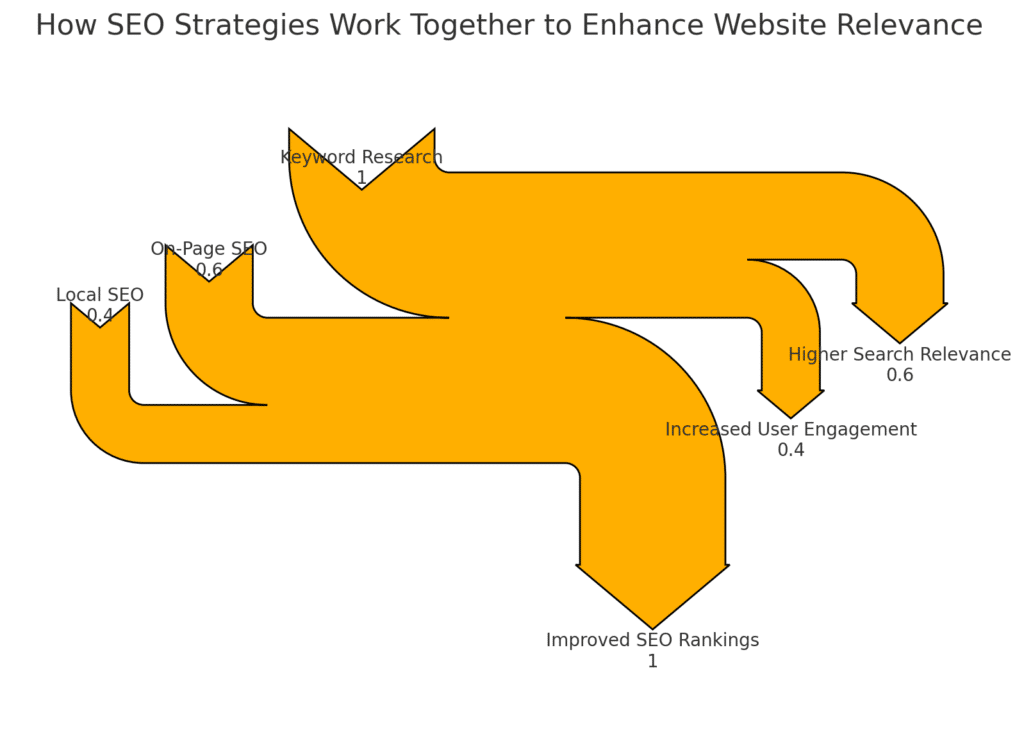Boost Your Cleaning Service's Online Success: Optimizing for SEO and Website Relevance
In today’s digital world, Search Engine Optimization (SEO) is crucial for ensuring that your cleaning service website is both visible and relevant. SEO involves optimizing your website so that it ranks higher in search engine results, making it easier for potential clients to find your business online.
By aligning your website with SEO best practices, you enhance its relevance not only to search engines but also to users. This relevance is key to attracting the right audience—people actively searching for the cleaning services you offer.
Furthermore, a well-optimized website helps establish your credibility in the industry, showing clients that your business is professional, trustworthy, and attentive to their needs.
To understand how we make your website more relevant, consider visiting our homepage, which dives deeper into strategies for enhancing online visibility.
Section 1: Overview of SEO and Website Relevance for Cleaning Services
Search Engine Optimization (SEO) is the process of enhancing your website’s visibility on search engines like Google, making it easier for potential clients to find your cleaning services. At its core, SEO is about aligning your website with what search engines and users are looking for. This alignment is what makes your website relevant—both in terms of content and structure.
A relevant website meets the needs of its audience by providing valuable, easy-to-find information that answers their queries. This relevance is achieved through several key components of SEO: audience alignment, which ensures your content speaks directly to the needs of your target market; user-centric design, which makes your website easy to navigate and pleasing to use; and timely content, which keeps your site updated with fresh, pertinent information. Together, these elements not only improve your search engine rankings but also enhance the overall user experience, leading to higher engagement and more conversions for your cleaning business. If you’re unsure about what elements to include on your site, What Should I Put on My Cleaning Business Website? provides a comprehensive guide.
Website SEO Optimization Scorecard
Evaluate how well your cleaning service website is optimized!
Are relevant keywords naturally integrated into your content, titles, and meta descriptions?
Is your website responsive and easy to navigate on mobile devices?
Does your website load quickly on both desktop and mobile devices?
Is your Google My Business profile fully optimized with accurate information and recent updates?
Section 2: Key SEO Strategies for Enhancing Relevance on Cleaning Service Websites
To enhance the relevance of your cleaning service website, focus on these essential SEO strategies:
1. Keyword Research
- Identify Target Keywords: Use tools like Google Keyword Planner to find the specific phrases your potential customers are searching for.
- Examples:
- “Office cleaning services”
- “Residential cleaning in [City]”
- “Eco-friendly cleaning solutions”
- Examples:
- Integrate Keywords: Incorporate these keywords into your website’s content to match what users are actively searching for.
2. On-Page SEO
- Optimize Titles and Meta Descriptions: Ensure each page has a clear, keyword-rich title and meta description.
- Example Title: “Professional Office Cleaning Services in [City] | [Your Company Name]”
- Example Meta Description: “Looking for expert office cleaning in [City]? We offer reliable, eco-friendly cleaning services tailored to your needs.”
- Enhance Content: Naturally include your chosen keywords throughout the content on each page. This makes your site more relevant and valuable to users.
3. Local SEO
- Use Location-Based Keywords: Optimize your content with location-specific phrases.
- Example: “Commercial cleaning in [City]”
- Optimize Google My Business: Ensure that your business information (address, phone number, hours) is accurate and consistent across all platforms.
- Encourage Reviews: Positive reviews on Google My Business can further enhance your site’s relevance and visibility in local searches.
By focusing on these key SEO strategies—keyword research, on-page SEO, and local SEO—you’ll significantly boost the relevance and visibility of your cleaning service website, making it more attractive to both search engines and potential clients. To take your site’s design to the next level, check out How to Design the Perfect Cleaning Service Website.
Section 3: Step-by-Step Guide to Optimizing Your Cleaning Service Website for SEO and Relevance
1. Optimize Website Content for Relevance
- Incorporate Relevant Keywords: Start by identifying the key phrases your target audience is likely searching for, such as “office cleaning services” or “eco-friendly cleaning.” Integrate these keywords naturally into your website’s content, including service pages, blog posts, and FAQs. Ensure that your content addresses the specific needs and pain points of your audience, such as how your services can help maintain a clean and healthy work environment.
- Use Engaging Headlines: Create headlines that are both attention-grabbing and keyword-rich. This helps with SEO and ensures your content resonates with visitors.
2. Improve Website Speed for Better User Experience
- Compress Images: Large image files can slow down your website. Use tools to compress images without losing quality to improve loading times.
- Leverage Browser Caching: Enable browser caching to store frequently accessed data on users’ devices, which reduces load times on subsequent visits.
- Minimize HTTP Requests: Reduce the number of elements on each page, such as scripts, images, and CSS, to speed up loading times. A faster website improves user experience, reduces bounce rates, and increases your site’s relevance.
3. Ensure Mobile-Friendliness
- Responsive Design: Implement a responsive design that adapts to various screen sizes, ensuring your website looks and functions well on smartphones and tablets.
- Test Mobile Usability: Use tools like Google’s Mobile-Friendly Test to check how well your site performs on mobile devices. Make necessary adjustments to ensure a seamless user experience on all platforms.
4. Set Up and Optimize Google My Business
- Claim Your Listing: If you haven’t already, claim your Google My Business listing. This makes your business more visible in local searches and on Google Maps.
- Complete Your Profile: Ensure that all business information, including your name, address, phone number, and operating hours, is accurate and up-to-date.
- Add Photos and Posts: Regularly update your Google My Business profile with photos of your work and posts about special offers or news. Encourage satisfied clients to leave reviews, as positive feedback enhances your local SEO and relevance in search results.
By following these steps, you’ll optimize your cleaning service website for both SEO and relevance, ensuring it meets the needs of both search engines and your potential clients. To see how these strategies can be practically applied, consider the insights shared in 8 Successful SEO Best Practices for Cleaning Services.
Section 4: Best Practices and Tips for Maintaining Relevance through SEO
1. Content Freshness
- Regularly updating your website’s content is crucial for maintaining relevance. Fresh content not only reflects the latest industry trends but also meets the evolving needs of your audience. Consider adding new blog posts, updating service pages with the latest offerings, and revising any outdated information. This continuous refresh keeps your site dynamic and signals to search engines that your content is current and valuable.
2. Earn Backlinks
- Building backlinks from authoritative websites is a powerful way to boost your site’s credibility and relevance. Reach out to industry blogs, local business directories, and partners to secure guest posting opportunities or to get listed on their sites. Engaging in community activities or contributing to local news can also earn you backlinks, further strengthening your site’s SEO performance.
3. Monitor SEO and Relevance Performance
- Regularly tracking your website’s SEO and relevance performance is essential to ensure ongoing success. Use tools like Google Analytics to monitor key metrics such as traffic, bounce rates, and conversion rates. Pay attention to which pages perform best and identify areas that may need improvement. Additionally, set up Google Search Console to keep track of your website’s search performance and address any issues that might affect your rankings.
By consistently applying these best practices, you’ll maintain your cleaning service website’s relevance and SEO effectiveness, ensuring it continues to attract and engage your target audience. For additional tips on enhancing user experience, check out How to Enhance User Experience for Cleaning Service Website.
Section 5: Real-Life Example: How Relevance Boosted SEO for a Cleaning Service
A local cleaning service, “Sparkle & Shine,” significantly improved its online presence by focusing on SEO and relevance. Initially, their website was not optimized for local searches, and traffic was minimal.
They began by conducting thorough keyword research to identify phrases like “commercial cleaning in [City]” and “eco-friendly office cleaning.” They optimized their website content with these keywords and updated their Google My Business profile, ensuring accurate business information and adding regular posts.
Within six months, “Sparkle & Shine” saw a 45% increase in website traffic and a 30% increase in client inquiries. The combination of optimized content, enhanced local SEO, and a well-maintained Google My Business profile made their website more relevant to both search engines and potential customers, leading to measurable business growth.
Conclusion: Taking the Next Steps
SEO is essential for cleaning service websites to stay competitive and relevant in today’s digital landscape. By optimizing your website with targeted keywords, enhancing local SEO, and maintaining fresh, engaging content, you can attract more clients and establish your business as a trusted provider in your area.
Now is the time to take action—start implementing the strategies outlined in this guide to boost your website’s visibility and relevance.
If you need further assistance, consider contacting our team for a personalized consultation.



